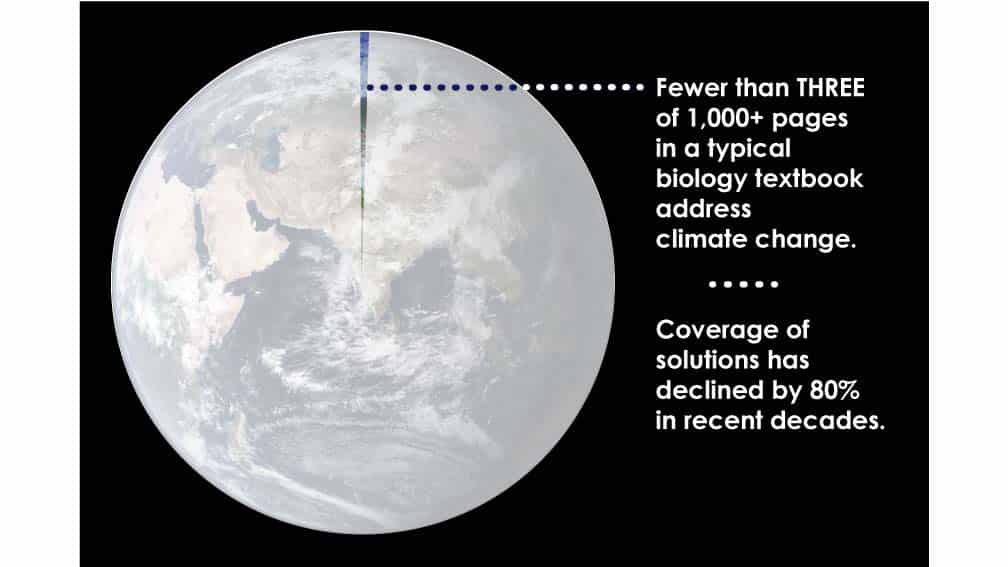For Immediate Release
A new study from North Carolina State University finds that biology textbooks have done a poor job of incorporating material related to climate change. For example, the study found that most textbooks published in the 2010s included less information about climate change than they did in the previous decade – despite significant advances in our understanding of how climate change is influencing ecosystems and the environment.
“In short, we found biology textbooks are failing to share adequate information about climate change, which is a generation-defining topic in the life sciences,” says Jennifer Landin, corresponding author of the study and an associate professor of biological sciences at NC State. “These books are the baseline texts for helping students understand the science of life on Earth, yet they are providing very little information about a phenomenon that is having a profound impact on habitats, ecosystems, agriculture – almost every aspect of life on Earth.”
For the study, researchers analyzed coverage of climate change in 57 college biology textbooks published between 1970 and 2019. The researchers found that climate coverage has varied substantially over those five decades.
Prior to 1990, textbooks had a median of fewer than 10 sentences addressing climate change. In the 1990s, the median length of climate content was 30 sentences. The median length of climate content rose to 52 sentences in the 2000s, which is not surprising given the amount of emerging research into climate change and its impacts. However, the researchers found that the amount of climate coverage in textbooks actually declined in the 2010s – dropping to a median of 45 sentences.
In addition to length, the nature of the content has also changed substantially over time. For example, sentences dedicated to actionable solutions to climate change peaked in the 1990s at more than 15% of the climate content. However, in more recent decades, actionable solutions make up only about 3% of the climate content.
“One of the most troubling findings was that textbooks are devoting substantially less space to addressing climate solutions now than they did in the 1990s – even as they focus more on the effects of climate change,” Landin says. “That suggests to students that nothing can be done, which is both wildly misleading and contributes to a sense of fatalism regarding climate change.”
In addition, the position of climate change sections keeps moving further back in the books, from the last 15% of the overall text in the 1970s to the last 2.5% of the text in the 2010s.
“This is important because most instructors present textbook content in order, which means topics at the end of the book are often skipped,” Landin says.
“However, it’s not all bad news,” Landin adds. “Textbooks in the 2000s and 2010s began including a wider variety of climate-relevant information, such as how climate is affecting species distributions, which can help students understand the various impacts of climate change.
“However, we are hoping that this study will serve as a wake-up call for publishers and instructors. We need to do a much better job of incorporating climate change into our courses if we want to prepare students to understand the role that climate change is playing in shaping life on Earth and how we study it.”
The paper, “Coverage of climate change in introductory biology textbooks, 1970-2019,” is published in the open-access journal PLOS ONE. First author of the paper is Rabiya Arif Ansari, a former undergraduate at NC State.
-shipman-
Note to Editors: The study abstract follows.
“Coverage of climate change in introductory biology textbooks, 1970-2019”
Authors: Rabiya Arif Ansari and Jennifer M. Landin, North Carolina State University
Published: Dec. 21, PLOS ONE
DOI: 10.1371/journal.pone.0278532
Abstract: Climate change is a potent threat to human society, biodiversity, and ecosystem stability. Yet a 2021 Gallup poll found that only 43% of Americans see climate change as a serious threat over their lifetimes. In this study, we analyze college biology textbook coverage of climate change from 1970 to 2019. We focus on four aspects for content analysis: 1) the amount of coverage, determined by counting the number of sentences within the climate change passage, 2) the start location of the passage in the book, 3) the categorization of sentences as addressing a description of the greenhouse effect, impacts of global warming, or actions to ameliorate climate change, and 4) the presentation of data in figures. We analyzed 57 textbooks. Our findings show that coverage of climate change has continually increased, although the greatest increase occurred during the 1990s despite the growing threats of climate change. The position of the climate change passage moved further back in the book, from the last 15% to the last 2.5% of pages. Over time, coverage shifted from a description of the greenhouse effect to focus mostly on effects of climate change; the most addressed impact was shifting ecosystems. Sentences dedicated to actionable solutions to climate change peaked in the 1990s at over 15% of the passage, then decreased in recent decades to 3%. Data figures present only global temperatures and CO2 levels prior to the year 2000, then include photographic evidence and changes to species distributions after 2000. We hope this study will alert curriculum designers and instructors to consider implicit messages communicated in climate change lessons.



